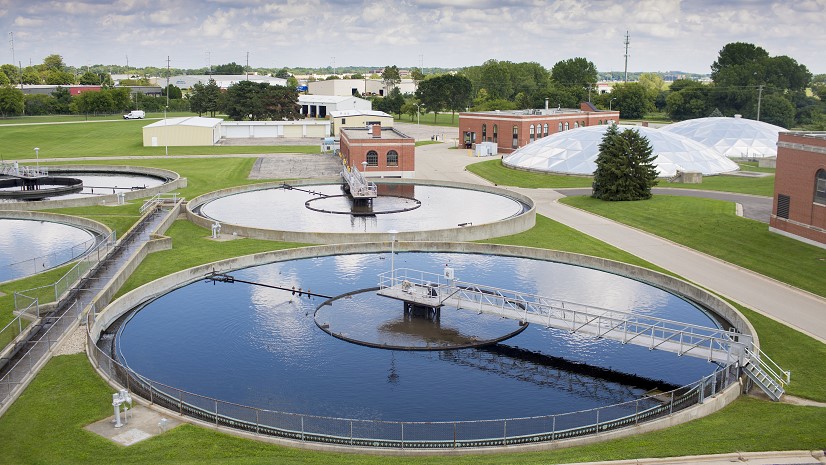There’s a special place in Connecticut where a group of innovative and thoughtful engineers and planners have developed an organization that understands the community they serve, and the challenges associated with maintaining a healthy and safe environment. If a sewer system backs up or a flood event causes a network-wide disruption, the communities they serve are at risk. The Greater New Haven Water Pollution Control Authority (GNHWPCA, or Authority) understands these concerns and has worked closely with its operations staff and contractors to develop inspection, analysis, and reporting tools that help plan, mitigate, and reduce risk as well as response times when unexpected events occur.
The GNHWPCA is a regional water pollution control authority created in 2005 under Connecticut General Statutes Title 22A, Environmental Protection. The GNHWPCA was created to operate and maintain the wastewater system of the constituent municipalities, City of New Haven, Town of Hamden, Town of East Haven and Town of Woodbridge.
Out of the four constituent municipalities, the City of New Haven is the only combined sewer system (CSS), a wastewater collection system designed to carry sanitary sewer wastewater and stormwater runoff in a single pipe to a treatment facility. In periods of heavy rainfall, total wastewater flows can exceed the capacity of the collection system and treatment facilities. When this occurs, the CSS is designed to overflow directly to surface water bodies such as rivers or coastal waters. These overflows are called combined sewer overflows (CSO). In 2001, prior to regionalization, the City of New Haven published its comprehensive CSO long term control plan as part of its requirements to comply with EPA’s Clean Water Act mandates. The long-term control plan included developing its GIS database to assist in the creation of the combined sewer system computer hydraulic model, and to perform pipe risk assessments to prioritize inspections and plan future rehabilitation projects. This was a good opportunity for the team of engineers, plant operators, construction, and finance professionals to combine forces and work toward the management of a common system that could be used to track the location and condition of all sewer utility assets.
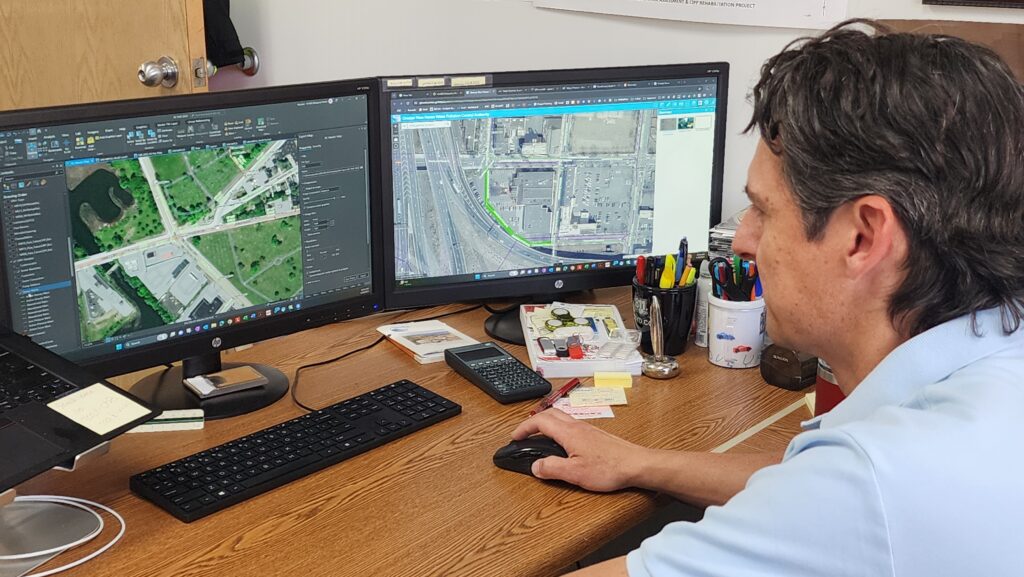
Building a System of Record for Sewer Utility Assets
The Authority requested proposals from GIS consultants and hired an Esri business partner to help centralize its GIS data into a common Geodatabase. Langan Engineering and Environmental Services LLC (Langan) was awarded the contract and continues to serve the GNHWPCA to this day. Senior engineer and GIS manager, Ricardo Ceballos, stated the goal was bringing in a partner that was highly responsive and was consistently up to date with the latest ArcGIS technologies used for stormwater and sewer utilities.
Today, the GNHWPCA engineering department utilizes ArcGIS to manage 600+ miles of sewer mains in its service area, and links to other helpful data feeds and sources like video captures from CCTV cameras used to inspect the inside of pipes and maintenance records.
“The flexibility of Esri’s configurable web application tools like Web App Builder and now its successor, Experience Builder, along with ArcGIS Dashboards have dramatically reduced the time it takes for us to provide GNHWPCA with helpful decision support maps and apps.” — Tony Yates, Associate Principal/VP, Langan
Another important factor for Ceballos and the GNHWPCA team was having a partner that was willing to invest time understanding the GNHWPCA short and long-term goals. These goals included for example thinking ahead about how to plan for major flooding and overflow events or more immediate needs like responding quickly and effectively to Call-Before-You-Dig (CBYD) 811 calls for utility locate services or reporting unplanned events like accidental line breaks. And like many communities, new construction and growth of residential homes and businesses alike requires proper planning for increased sewer flows as well as capital planning and budgeting for the addition of new sewer infrastructure.
Maps and Apps Make an Impact
The team has made steady progress over the years and today the ArcGIS system is serving the needs of a wide group of users. A variety of web and mobile applications are used to monitor and maintain the health of the regional sewer system and integrated utility network.
Examples of these applications and the users supported include:
- The integrated utility network, which enables operations staff, collections crews, and emergency response contractors to better plan and understand large storm related flooding events and storm surge (e.g., Hurricanes Sandy and Ida) and anticipate when regulator heights will be crested so proper mitigation and response teams and actions can be taken to reduce the impact of CSOs.
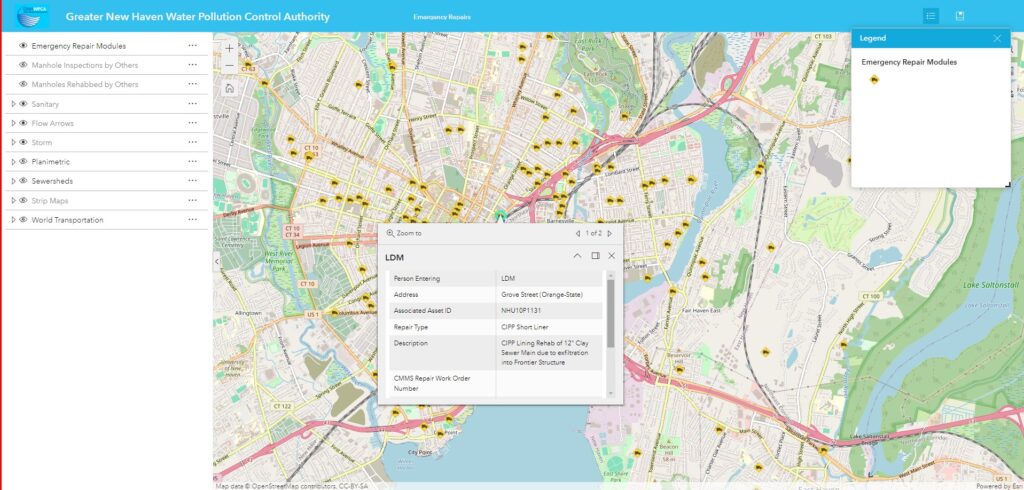
- ArcGIS Pro analysis tools that assist engineers and planners with site plan review and hydraulic modeling when adding new infrastructure as well as load and thresholds for expanding treatment plant capacity.
- The integration of sewer maps and asset location data with GNHWPCA’s incoming ticketing request and notification system (upwards of 40 calls/day), which helps the public with CBYD requests and quickly returns accurate maps. The result being a dramatic reduction in “truck rolls” (nearly a 100% reduction minus calls for projects near force mains) to respond to unplanned infrastructure damage events and automating the process of providing accurate sewer records to contractors in the field.
- Mapping and tracking of sewer infrastructure capital projects by repair or replacement type and date completed supporting historical project tracking and reporting. These tools are directly assisting GNHWPCA Engineer planning and permit approval tasks as well as inspections being performed by Collection crews.
“Documenting and communicating sewer system maintenance and inspection requirements and results is readily accomplished and coordinated among departments”. — Dan Wolff, GNHWPCA Collections System Manager
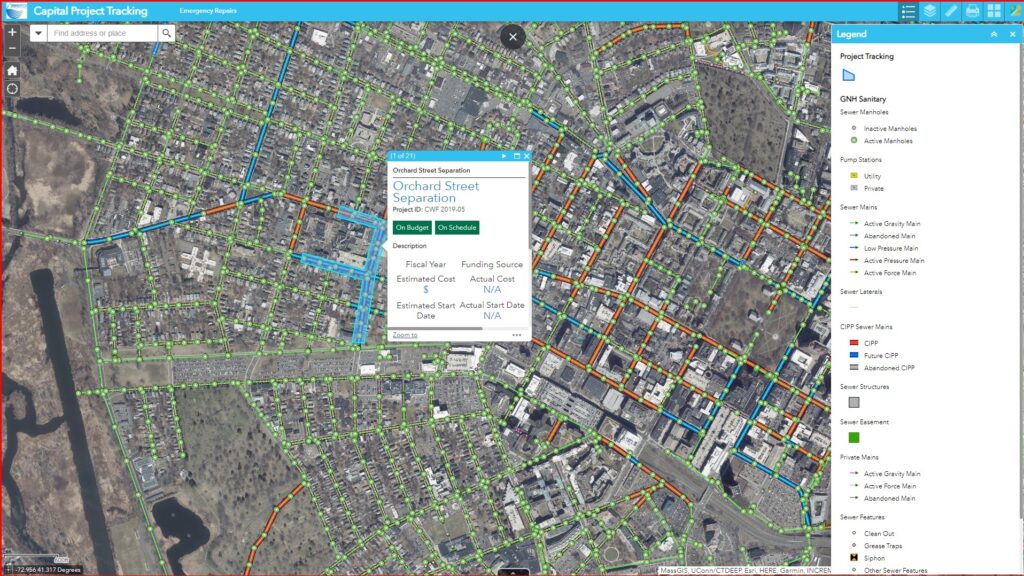
- Mobile ArcGIS Survey 123 and Field Maps tools that assist inspectors locating and assessing the condition of sewer infrastructure.
Other tools that feed the central Geodatabase, capabilities, and connected, web-based map apps that support GNHWPCA decisions include:
- Mobile maps for contractors showing them where new service connections should be made to existing infrastructure (i.e., preventing second guesses on where to dig, where to tie-in).
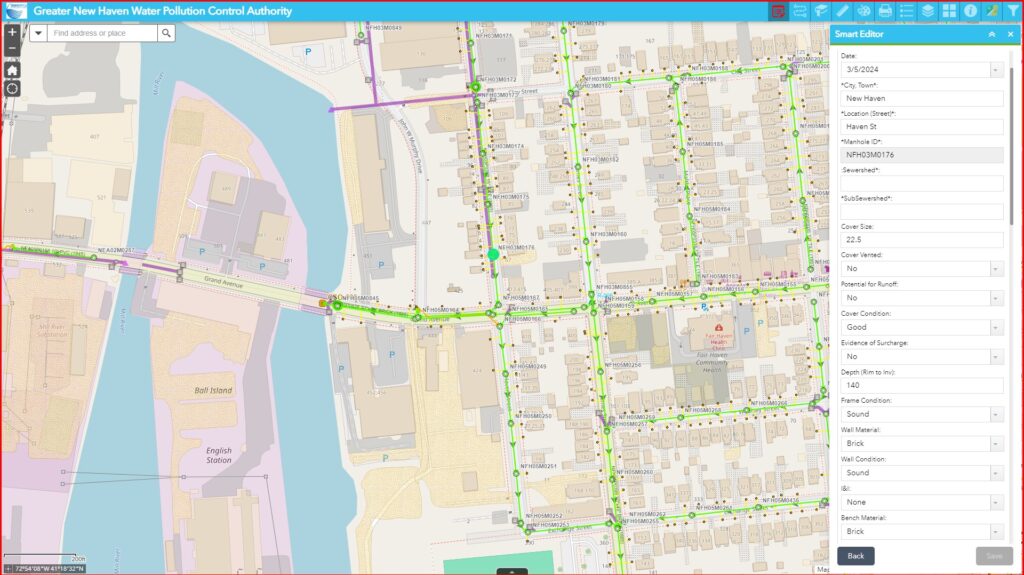
- The ability to see where to focus CCTV camera inspections, conduct planning/budgeting for those activities, and using the results of those inspections determine the best repair or rehabilitation technology like cured in-place pipe (CIPP) lining.
“Conducting engineering evaluations on pipe segments flagged by the collections department is streamlined by having both visual and up-to-date records data on the sewer system, its history and the service area in one central location”. — Isabella Schroeder, PE, GNHWPCA Senior Engineer
- The ability to monitor tree roots and potential for root intrusion of sewer infrastructure, determining the best treatment options, and web map apps showing preventative maintenance activities. These show where and when treatments have been applied, and associated budgets for capital planning – data also important for Department of Energy and Environmental Protection, or DEEP, reporting.
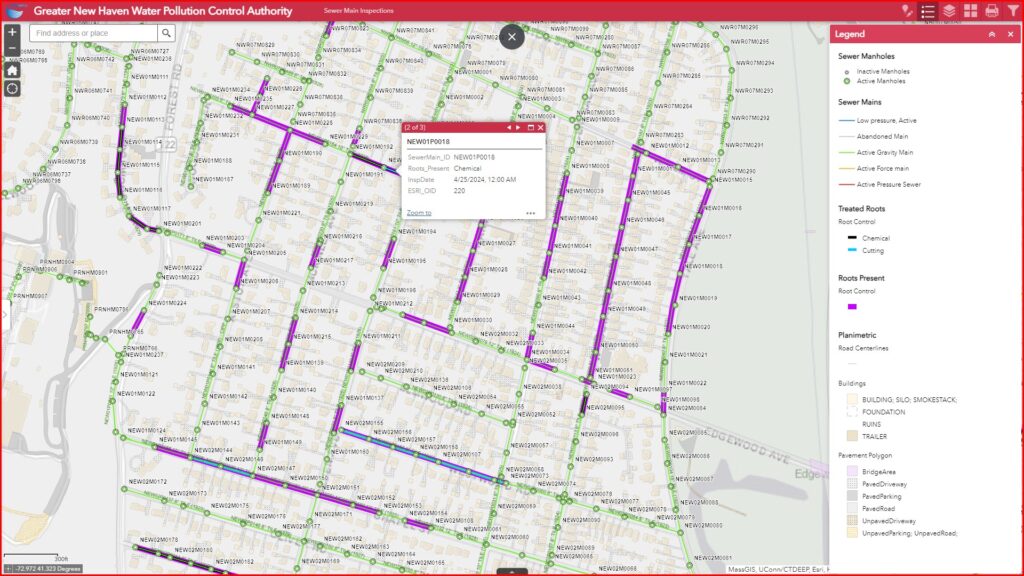
- Monitoring and recording the condition of pipes for the presence and amount of FOG (fats, oils and grease) inside pipes typically downstream of contributing food establishments/businesses and providing web map apps showing the status of those cleaned and treatments performed. Also showing the geographic relationship between the location of FOG build-up and the closest potential contributors.
For each example provided above, Ceballos underscored tasks that once took hours or days can now be completed in less than an hour following the implementation of a centralized Geodatabase and the establishment of industry best practices for managing and maintaining the ArcGIS Enterprise system. “We are continuously finding new ways to streamline our business workflows and deliver easy-to-use decision support apps and tools for our stakeholders”, said Ceballos.
Continuing to grow the Impact of GIS
More recently and looking forward on the GNHWPCA roadmap, Ceballos and team have been exploring the use of Esri’s ArcGIS Network Management (EANM) capabilities. They have converted their previous Geometric Network largely used to trace downstream impacts of planned or unplanned failures of the sewer system, to the latest ArcGIS Utility Network data model and analysis tools. A key area to gain value is integrating the new EANM capabilities with GNHWPCA’s customer information system (CIS) to take advantage of utility network traces that show impacted customers and trigger automated notifications to potentially impacted customers. “This is especially important for notifying the facility operators responsible for hospitals, schools, and businesses as well as individual residents”, stated Ceballos. Yates said, “Esri’s Utility Network Management tools are opening new options for both maintaining GNHWPCA’s expanding sewer infrastructure network as well as the tools needed to improve service to the GNHWPCA communities.”
In addition to the new analysis tools and system integrations currently being tested, the team is implementing new cartographic methods for symbolizing sewer infrastructure assets, so they provide a more realistic representation of what is happening underground. This is especially true at manhole cover junctions where it’s important to better symbolize these junctions to reflect the real world where pipes meet the manhole wall (not the center of the manhole).
GNHWPCA is also planning to explore ArcGIS Indoors as a solution to map the detailed interior spaces of the Authority’s large pumping stations, and the wastewater treatment plant. The new ArcGIS Pro Flood Analysis tools being released with version 3.3 will also be reviewed.
“ArcGIS provides many opportunities to improve our planning and response for the GNHWPCA community and we are committed to continuous improvement of our services.” — Sid Holbrook, GNHWPCA Executive Director
Stay Connected with Esri’s Water Team
ArcGIS is an extensive information system that enables modernization of workflows with easy-to-use applications for the field and office. Strengthen your organization with smart water solutions that will increase efficiency and provide insight for decision-makers.
Visit the Esri Water Utilities web site for more information.
Join the Water Utilities Community
Follow #EsriWater on social media: X| LinkedIn
Subscribe to the Water Industry newsletter “Esri News for Water Utilities and Water Resources“


